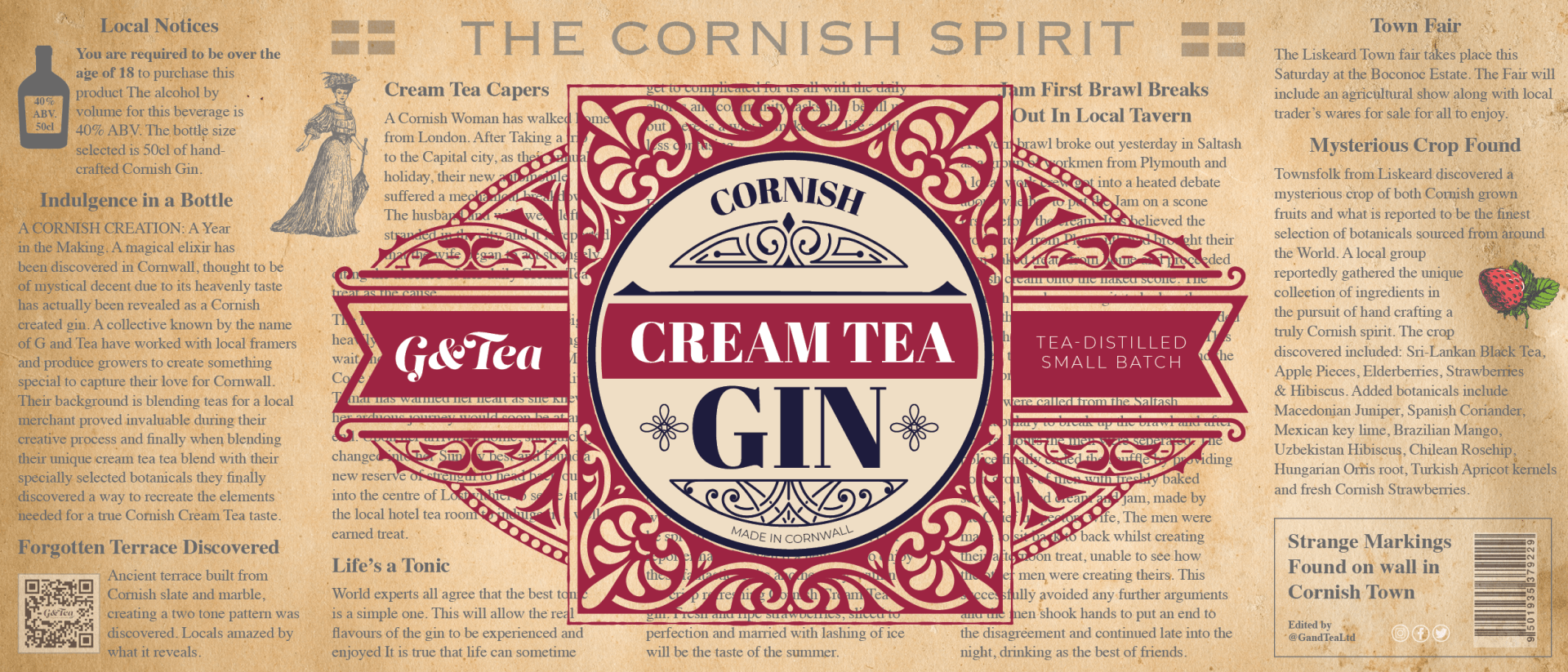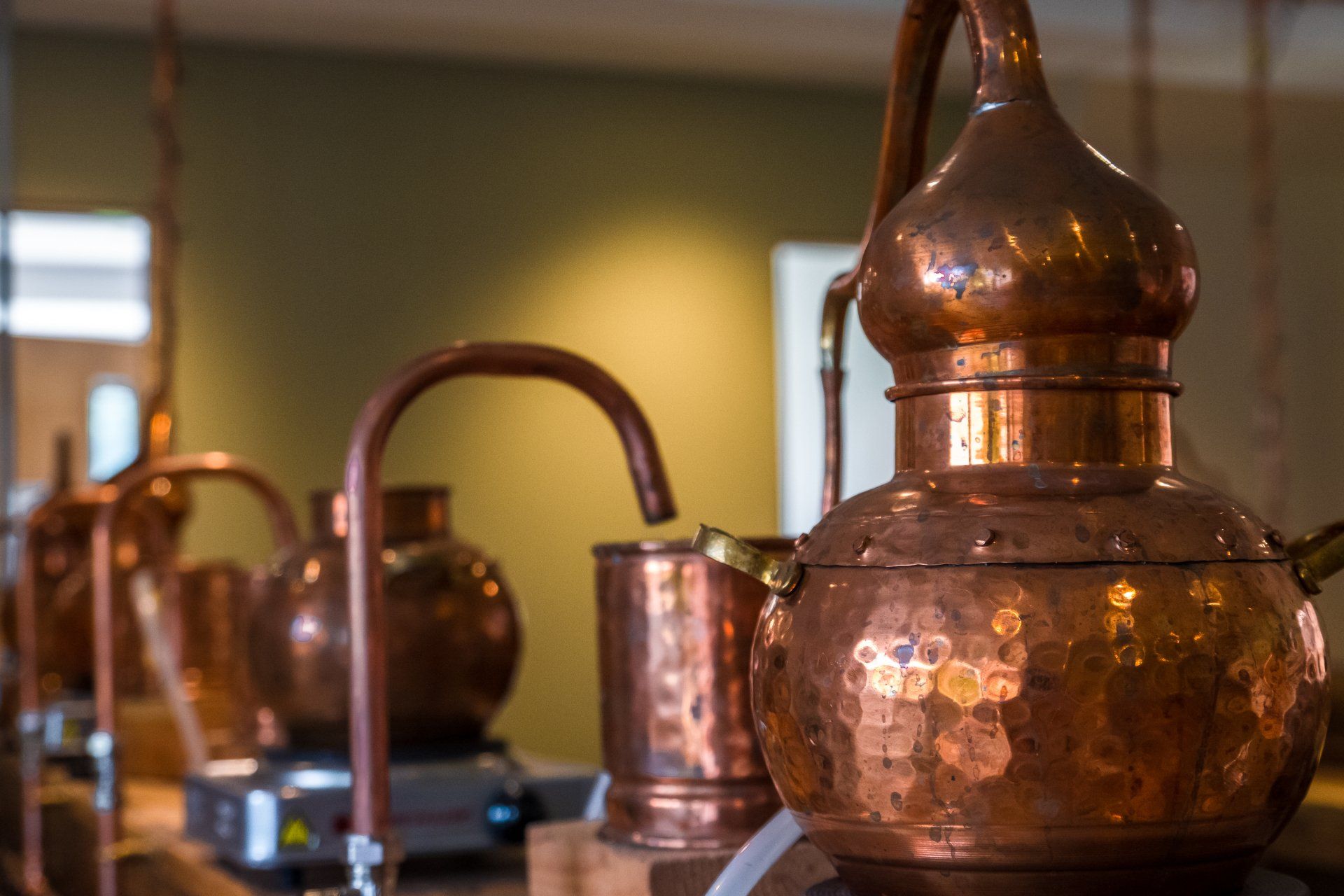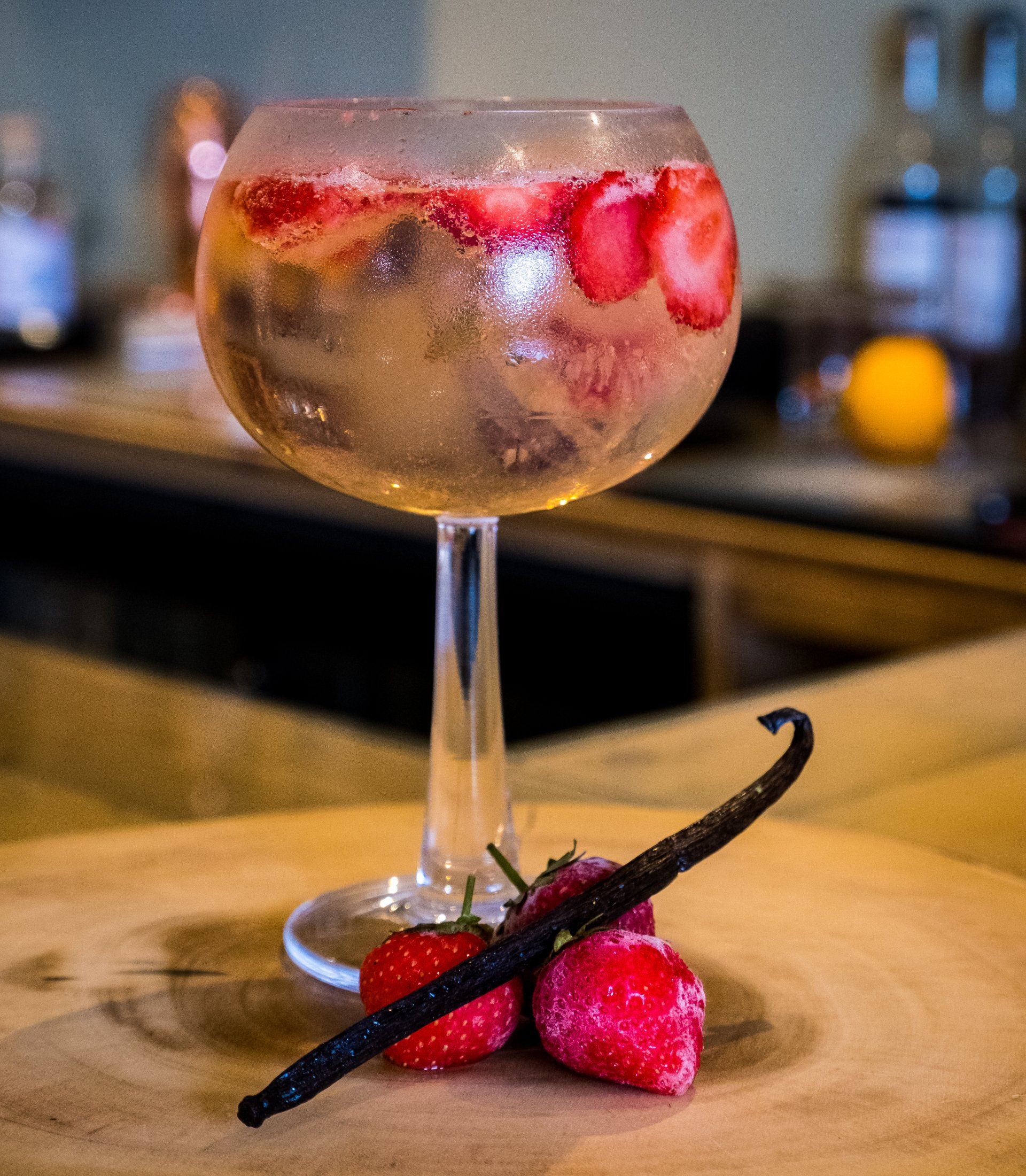5 Fantastic Facts about Gin
Kirsty Jones • 29 January 2021
5 things you may not know about Gin

In recent years Gin has had a massive resurgence becoming one of the most popularly consumed alcoholic beverages enjoyed by many around the world. Other than being famous for the flavour of Juniper berries, most people don’t actually know very much about their beloved gin, other than it goes great with Tonic Water. So here at G&Tea we thought we’d bring you some rather interesting facts about gin that you may or may not know from Gins most historic food pairing to the antiques of a clever cat.
Gin was originally A Medicine
It can be argued that the origins of Gin began in Europe during the Middle Ages where it was used for many years as a medicinal tonic. Popular in the Netherlands, a malted, Juniper flavoured spirit known as “Jenever” or “Genever'' (the Dutch word for juniper) was produced by clever monks and chemists and used to treat a number of ailments.
This tonic was said to help treat anything from gout, gallstones, stomach and kidney disorders to improving one's circulation and alleviating anxiety. It is reported that during the 30 years War, British soldiers who fort alongside Duch troops were given Jenever to ‘calm their nerves’ before going into battle and this is where the famous phrase ‘Dutch courage’ is said to come from.
Gin Created A Stir!
In the 17th Century William of Orange and his wife Mary popularised Genever as an exotic drink to England's elite but it quickly became popular with the poorer citizens as well who desired a change from the French brandy, ale and beer they’d been used to. The Government at the time encouraged London distillers to make English Gin, (different to the more whisky like Genever) to help replace the French Brandy imports they had restricted. By the early 18th century however, the over consumption of gin had become so extreme among the lower classes that the period became known as the great “Gin Craze”.
It is reputed that in the year 1721, there were over 6,000 places in London alone where you could buy gin and the brits consumed 3.5 million gallons of it! Needless to say, the drunken behaviour led to the term “Mother’s Ruin” and the government made huge efforts to outright ban the poor from drinking gin by bringing in the “Gin Act” restricting its sale, production and taxing it heavily. The result of which was huge uproar from the people, Gin riots and a rise in illicit gin production.
Gin: The Cat’s Whiskers
If anyone thinks the vending machine is a new invention then think again as Gin got there first. During the famous 18th century “Gin Craze”, when gin was taxed heavily and it was illegal to produce or sell it without an expensive license, bootleg gin was in huge demand. The rather sneaky but entrepreneurial Captain Dudley Bradstreet came up with an ingenious idea to make some much needed money and reduce the risk of getting caught by the authorities for selling the Gin without a licence by inventing the Puss-and-Mew machine’.
Captain Bradstreet took his last bit of money and purchased some quality gin from a local distillery and a wooden sign with a cat on it. He then nailed the cat sign over the front of a window in an alleyway. The sign also now had a small lead pipe sticking out slightly under the paw of the cat. Soon rumours were circulated that if you visited the cat, put money in its mouth and said ”give me two pennyworth of gin” It would dispatch a small amount of gin through the pipe to the waiting person!
As you can imagine this spread like wildfire and the Puss-and-Mew did a roaring trade. Copy-cats (excuse the pun!) popped up all over the place as a way to buy illicit gin and how it affectionately became known by many as “Old Tom” a Tom being the name for a male cat.
Gin was added to Tonic
We all know it as a Gin & Tonic (or in our case a G&Tea), but did you know that originally it was Gin that was added to tonic and not the other way round?. We go back to the 19th century in India where many British officers were drinking Indian Tonic water by the gallon in a bid to ward off Malaria spread by those pesky mosquitoes.
However the quinine in the tonic water tasted extremely bitter and people found it hard to drink even though it had clear medicinal benefits. To help overcome this problem, some absolute legends started adding sugar, lime and their Gin rations to the tonic to find something more palatable and so the classic Gin and Tonic was born.
Gin used to be sold with Gingerbread
One of my absolute favourite facts about gin (other than the Puss and Mew Machine) is that for well over 150 years Gin was sold to the public with Gingerbread. This classic taste pairing goes back again to the 17th and 18th century in England when it was popular in the cold winter months for vendors to set up marketing stalls selling cups of hot Gin and freshly baked Gingerbread.
This was especially big in London when the river Thames would regularly freeze over and people would flock to it to ice-skate. Sometimes the hot gin toddy would have lemon added to it and was known as a Gin Twist.
While there is without doubt many interesting gin facts we thought that these were some of the more fun or unusual ones and hope you enjoyed reading them.
Have you tried a hot gin toddy with gingerbread?
This works well with our Great Earl Gin
and for a G&Tea twist add a slice of orange peel for the perfect warming treat on any cold day.

When the team at G&Tea Limited first decided to create a range of hand crafted Cornish gins in what is, let's face it, a crowded market place, they knew having a distinct point of difference was vital to establishing and growing their brand. Born from their existing Coffee & Tea business, Majestic Coffee South West and having secured the perfect business and domain name for their plans, GandTea.uk, the team set to blending 3 unique teas from which they would distil their gins. Working with the expert team at Lostwithiel's very own Colwith Farm Distillery, Cornwall's only plough to bottle distillery, creating artisan gins using potatoes grown on the farm, the team spent several months perfecting both the tea blends and wonderful array of botanicals, locally sourced from right here in the South West where possible. As with most businesses, G&Tea have aspirations to take their range of gins National, proudly flying the flag for Cornwall and there is no doubt their incredible 80days and The Great Earl gins do exactly that! However it was important to them to have, within their range, a gin that captured even more of the Cornish spirit. To create a gin that felt at home here in Cornwall for residents and tourists a like to enjoy. To create a gin that could become a staple of the classic gifts and souvenirs often bought and sent travelling back home with the millions of people who come and experience the joy and delight that is Cornwall. It was clear to them nobody would want a Cornish Pasty gin and with a selection of their range of botanicals already sourced from within the Cornish Countryside, the choice was clear. They set about capturing the flavours and very essence of the indulgent delight: The Cornish Cream Tea; and capture it they have with a tea blend that evokes the smells and tastes of the cream tea at its core and with the addition of cleverly balanced botanicals and fresh Cornish strawberries. The brand director for G&Tea, Liz Hyde from Elizabeth Hyde Design created a stunning brand identity that incorporated some of the main botanicals in each gin blended with a tea leaf design, highlighting their unique tea distilled range. It was important to them to highlight that all three gins were distilled with the teas and unlike some gin brands, nothing was added such as flavourings or colourings after the distilling process. This purity they had strived to achieve was reflected in the simplistic style of the design. This worked well as evident by the customer response to the branding. With so many aspects to their business being rooted in Cornwall there was only one choice of how to launch, The Cornwall Channel! What a launch it was too with music from the talented Terrie-May McNulty and hosted by the incomparable Lucy Start, co-host of the much listened too local radio breakfast show. Their launch is still available to watch on their Facebook (@gandtealtd) and you will recognise a familiar face from right here at Quay Magazine tasting the gins for the first time. The reaction G&Tea got was fantastic from both locals and people from all over the country who subscribe to the Cornwall Channel. Their plan had been to focus on getting the gins out to the public directly in preparedness for creating a trade business offering the products into retails and bars, hotels and beyond in 2021. Giving them the chance to get customer reaction to each gin blend, which would in turn drive the branding and sales for the trade side of the business. The demand from the trade, however, came almost instantly and so the team had to adapt quickly, bringing their planned schedule of growth forward. A great problem to have, I hear you cry and yes, of course, a instant demand for your product is the dream. The one thing they were missing was that all-important feedback in advance of producing the larger bottles. With over 60 stockist throughout Cornwall and Devon the team adapted and held gin tastings events with a number of their stockists taking note of all the feedback from both the customers and their stockists. (back of course in the heady days of Tier One) Christmas markets and events throughout the county also served as a great source for them to get feedback and as Chris Robinson-Brown, managing director, told us “the feedback we received from both customers and the trade a like was invaluable and helped us realise we have three very distinctive gins and that each should be allowed to show its own personality within the overall brand of G&Tea” Lock down three then arrived and the team saw this as the perfect opportunity to set about creating the three individual identities for the gin range, starting with their take on the Cornish Classic Cream Tea. Brand Director Liz told us “People have gone crazy for the taste of our Cornish Cream Tea gin and tea blend and we had some fantastic input to help evolve the brand, and the following points were re-occurring: The label doesn't reflect the high quality of the gin itself, the branding needed to focus more on the gins Cornish roots and finally that the bottle needed to have greater presence on the shelf. “ Although dating back beyond this, the afternoon cream tea really came into its own in the mid 19th century and so we started our design by creating The Cornish Spirit, our very own vintage newspaper as the background, with the team each creating some of the intriguing stories featured. On top of this, we then wanted to capture a classic look and created the ornate label design mirroring design style of the same mid c19th era. The Cornish Spirit itself then took on a life of its own and will now be the focus for a customer newsletter and will be making numerous appearances in the future as part of social media campaigns, with customers being invited to create some content and share their cream tea gin experiences. Chris went on to say “especially with our Cream Tea gin the on the ground response was vital to evolve the brand and we believe that by working with our growing network of independent Cornish traders and some exciting events we have under our sleeve once Covid restrictions are lifted, that Cornish Cream Tea gin can become a staple of any trip to Cornwall and a favourite holiday gift item too. We are already working with several businesses to add our gin to their Cream Tea delivery services, as a boozy cream tea pack. Again the purity of the gin is a big factor in this and we are so pleased we went down this route instead of simple flavourings and colourings which would have not allowed for the brand to grow and for us to create this classic styling it now has”.

Here at G&Tea, we are delighted to bring you a range of expertly crafted tea inspired gins where everything is delicately produced from scratch on a single estate situated in the beautiful Cornish countryside. We have launched our exciting tea-inspired, plough to bottle gin range by bringing you three distinct offerings, The Great Earl, inspired by the classic Earl Grey tea, Cornish Cream Tea, inspired by the traditional afternoon tea and Eight Tea Days which is inspired by fragrant teas from around the world. Each handcrafted gin has been carefully created using the finest speciality tea blends and natural botanicals. Down At The Farm When making our Tea Inspired Gin range, we wanted to bring something different to the table for our fellow gin lovers. An important part of that was collaborating with the experts at Colwith Farm Distillery who are Cornwall’s first plough to bottle vodka and gin distillery and famous for their Stafford’s Gin and Aval Dor Cornish Potato Vodka. They are just one of a very small group of expert UK distillers who delight in bringing the whole gin-making process under one roof helping us to create something really special for our customers. From ploughing the crops used in the alcohol making process at the farm, through to lovingly distilling the gin, tea and botanicals in copper stills and then hand-bottling the gin on-site, even the water used in the production process comes from an aquifer situated beneath the distillery meaning the entire process has a small carbon footprint and everything is made with local ingredients where possible. We hope you enjoy trying the G&Tea Grand Tea range of Cornish Plough to Bottle handcraft Gins. Why not check out our blog of top serving suggestions for the G&Tea range. Don’t forget to tell us which is your favourite G&Tea and follow us on social media. @gandtealtd

The Grand Tea Gin Range - Perfectly Poured Here at G & Tea headquarters, we have worked hard to bring you the Grand Tea range, an exclusive trio of small-batch plough-to-bottle gins that are distilled and infused with beautiful teas and carefully selected botanicals from around the world. When it comes to drinking our gins (responsibly of course!), there are a number of ways that you can enjoy them and we have outlined our favourite serving suggestion for each gin below. The Great Earl Gin: A distinguished gin that headlines our fabulous Grand Tea range. Infused with Ceylon tea sourced from the foothills of Sri Lanka, vibrant notes of bergamot, lemon, bitter Spanish orange, warming Cornish Bay leaves and Macedonian juniper. This gin feels like a classic already and we love to serve it as follows. Gin Balloon Glass Chunky Ice Cubes Fresh Orange peel with pith Cinnamon Stick The Great Earl Gin 3 parts Tonic Take a chilled gin balloon glass and fill it with chunky ice cubes. Spray the aromatic essential oils from a piece of fresh orange peel over the ice, add the cinnamon stick and a generous slice of orange peel to the glass. Pour over The Great Earl Gin and finish with 3 parts tonic water. Sit back and enjoy a taste of luxury. Cornish Cream Tea Gin: Celebrating the afternoon delights of a traditional Cornish cream tea, this delicate gin incorporates our exclusive cream-tea blend with fresh Cornish strawberries, hibiscus and rose-hips amongst other fine botanicals. Handcrafted in small batches in Cornwall, this gin is smooth on the palate and makes the perfect souvenir or gift. We recommend the following serving suggestions to enjoy a taste of the glorious South-West. 1 High Ball Glass, Chunky Ice Cubes, 1 strawberry quartered, 1 full strawberry for garnish, Cornish Cream Tea gin, 2 parts tonic Add chunky ice cubes, layered with the quartered fresh strawberries to a high ball glass. Next, take the whole strawberry, make a small cut into the bottom of it and run it around the top of the glass once to flavour and the rim, leave on the edge of the glass to garnish. Now pour your Cornish Cream Tea gin over the ice and strawberries and top off with two parts tonic water. Why not enjoy this serving suggestion along with some delicious freshly baked scones. 80 Days Gin: This worldly gin is a real voyage of discovery on the palate, including British royal gala apples, rose petals from Pakistan, Hungarian orris root, Chinese cassia and exotic grains of paradise from the Ivory Coast. Eight Tea Days is the perfect gin for those on a voyage of discovery and we enjoy serving it with juicy slices of apple and pear. Gin Balloon Glass, Chunky Ice Cubes, Fresh Apple slices, Fresh Pear Slices, Eight Tea Days Gin, 3 parts tonic Place chunky ice cubes into a chilled gin balloon glass. Add slices of ripe, fresh apple and pear and flavour the rim of the glass with a slice of the pear by running it around the rim of the gin balloon. Pour your Eight Tea Days gin over the fruit and ice and add 3 parts tonic water. Sit back and let this gin takes your tastebuds on a tour around the world. SIP SIP HOORAY! We know that some people don’t like to add mixers to their gin, so if you are a gin connoisseur and enjoy the sipping experience of drinking your gin neat, we would suggest pouring your favourite from the Grand Tea range over a few ice cubes to savour the gin at its purist and enjoy the full flavours and delicate aromas. We are proud of the individual characteristics of each of the gins in the Grand Tea range, we hope you enjoy trying out these serving suggestions

